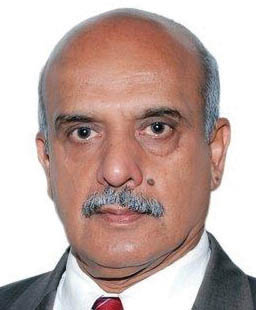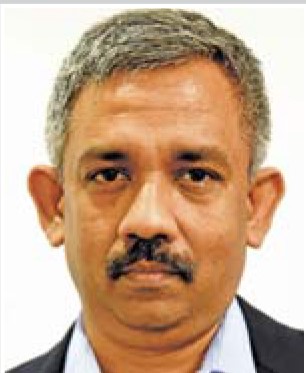The impact of the Covid-19 outbreak on the power sector is expected to be far-reaching. Electricity demand has already seen a decline as a result of the shutdown of industrial and commercial establishments. This, in turn, is expected to have a major impact on the liquidity profile of the financially weak discoms with a loss in revenue collection, which may result in payment delays to gencos and transmission companies. Power Line invited industry experts to analyse the current and potential impact of COVID-19 on the power sector and the measures needed to cushion its impact…
What has been the impact of COVID-19 on the power sector? What has been the trend in power demand?

Rohit Bajaj
In the last few days, the industrial demand has seen correction because of the preventive lockdown due to COVID 19. Two of the largest consumers of power both the industrial sector, as well as railways, are operating at limited output. The demand for power has corrected by about 20-25 per cent even though there is some offsetting by increased domestic consumption as a result of work from homes and the demand from healthcare-related infrastructure. The exchange power market has seen some changes as well. The day-ahead market on the exchange platform has surplus availability of power as sell-side is almost 3 times of the total buy. As a result, the prices in the exchange market are the lowest in the last two years. The price discovered at Indian Energy Exchange platform is at all-time low with the average price in March 2020 at only about Rs 2.46 per unit. The distribution utilities can make use of this opportunity by replacing their high variable cost power and buy electricity from the spot market and supply 24*7 power to all consumers. The other key aspect is the liquidity crunch at the end of the distribution utilities whose revenues are impacted. To support the utilities, the government has announced some measures, and few may also be underway like special financial packages and making direct payments to the generators through Power Finance Corporation Limited (PFC) andREC Limited. On the coal front, there has been a steady supply of Coal with the thermal generators and all-time high coal reserves available with the generators. Hence, a swift spring back to a strong and stable economy post effective containment of the virus should not be an issue.

Pankaj Batra
Power demand has dropped by 20-25 per cent due to the lockdown on account of COVID-19, from 158,672 MW on March 14 to 123,196 MW on April 6, 2020, and from 148,780 MW to 119,374 MW at 19:00 hours during these days, as per the daily power supply position report of POSOCO. The percentage consumption from commercial load, i.e. shops, offices, as per CEA statistics, is conventionally about 8-9 per cent, that from the industrial sector is about 41-42 per cent and that from the domestic sector is about 24-25 per cent. Electric traction contributes to about 1.5 per cent, which would have become zero. So, I guess the biggest contributors to the reduction in load are on the commercial and industrial sides. Power demand in the future would depend on the extent to which the lockdown is reduced and at what stage. This, I guess, depends on the considered decision taken by the government.

Devtosh Chaturvedi
Due to the COVID-19 pandemic, a nationwide 21-day lockdown has been imposed by the government from March 25 to April 14. As a result, industrial and commercial activities have come to a standstill. This has resulted in a sharp decline of around 40 GW in power demand from 160 GW (pre-lockdown) to approximately 120 GW. It is expected that lifting of the lockdown and normalization is subject to effective containment of the pandemic. As per the indicators available, we may see a phased restoration of commercial and industrial demand in the next couple of months. The picking up of industrial demand will also be closely watched as the impact of the impending labour crisis on production is yet to be ascertained.

Anish De
Industrial, commercial, and traction demand has been hit especially during the lockdown period. Domestic demand has increased. Total electricity demand has been significantly affected (negative 26 per cent) in first week of lockdown.Uncertainty on the lockdown period is likely to continue. Medium and long-term demand growth is likely to be tepid till economy regains the pre-COVID-19 activity levels.It will be a long road to recovery. So while there will be spurts when the lockdown ends and the situation comes back to control, the overall effects on demand will play out for some time. Demand was generally weak in the second half of 2019-20 and the gap that has now emerged will be difficult to make up. Hence, estimated supply requirements will also be affected and will hit the new project pipeline

Pramod Deo
The electricity demand has reduced significantly as commercial and industrial (C&I) consumers have shut operations due to the Covid-19 or more popularly lockdown. It is, however, difficult to say how the power demand will change in the next couple of months as it will depend upon how the Covid-19 situation evolves. Indian economy will take time to revive after the lockdown is completely lifted.
The distribution companies (discoms) are facing numerous issues because of the present conditions. Notably, Commercial and Industrial (C&I) consumers account for a major portion of their revenues and today revenue collection from these consumers has dropped considerably. Since C&I customers subsidize agriculture and lifeline domestic consumers their contribution to the revenues of discoms is crucial for the financial health of the utilities. Additionally, in the lockdown situation, the billing can only be done on average basis as meter reading has been deferred by the discoms. This will severely impact the financial position of the discoms.
The larger problem is that discoms will be unable to pay to the transcos and gencos. Already some states have started invoking ‘force majeure’ clauses of power purchase agreements (PPA) to defer payments to gencos. In pursuance of the policy directives issued by the Government of India to the Central Electricity Regulatory Commission (CERC), the latter has released a suo moto order for deferring payments for projects under Section 62 of Electricity Act, 2003 (i.e., where tariff was decided on cost-plus basis). However, this order does account for the accumulated accrued interest to be paid by the discoms later. For gencos and transcos whose tariff was determined under Section 63 of EA 2003 (competitive bidding basis), discoms may claim the relief from its obligations as per the force majeure provisions given in the respective power purchase agreements (PPAs).
It is expected that payment issues will result in a prolonged stalemate or litigation between the discoms and independent power producers (IPPs). The discoms are always short of funds as the state governments want to give a variety of concessions to a selected class of consumers and the current situation will only worsen the finances of the latter.
Presently, electricity demand has dipped significantly but as the demand picks up, the gencos will need to make payments to the Indian Railways and Coal India Limited. The current moratoriums on payments cannot be continued for a long time because these companies too need to function as commercial enterprises. We cannot have a situation where payments are deferred indefinitely.
Finally, the distribution reforms that were being proposed by the central government such as stringent lending norms and target-based incentives/disincentives will take a backseat now. The central government will now find it difficult to be strict with the state discoms. The discoms will have an excuse because of the challenges thrown by Covid-19 crisis. We can only hope that the situation stabilizes as early as possible but the sector reforms have been pushed by a year or two at least. With the current situation, it is impossible to implement distribution reforms.

TN Arun Kumar
Government of India on March 25, 2020 announced an unprecedented 21 days lockdown to stem the spread of COVID-19 pandemic. The lockdown has resulted in suspension of industrial and commercial activities including passenger rail transportation accounting for bulk of power demand in the country. As per initial estimate, the electricity consumption has declined by more than 20-25 per cent over the second week of March 2020. Also the electricity consumption was even lower as compared to corresponding period last year. The closure of factories and commercial establishments reduced buying by the power distribution companies (discoms) led to the slump in the power demand.

Sambitosh Mohapatra
Economic slowdown along with the immediate impact of lockdown during COVID-19 has had a sobering impact of demand which has gone down by close to 30-35 per cent. The demand mix post constituted domestic – 25 per cent, industrial – 41 per cent, commercial – 9 per cent, agriculture – 18 per cent and others – 7 per cent after adjusting for 25 per cent proportionate transmission and distribution losses. With industrial and commercial consumption significantly lower, the overall demand came down by 30-35 per cent. The peak demand is hovering around 110-115 GW down from 170-175 GW.
Interesting to note was the #9PM9Min lights off campaign onApril 5, 2020, gave an insight to the real domestic demand and how losses are getting apportioned. While experts estimated 12-14 GW of lighting demand to go down, actual demand went down by close to 32 GW.

S.L. Rao
The electricity demand has already dropped since many manufacturing units have halted production. Similarly, commercial establishments like cinema halls, malls, museums, etc, are all in shut down mode, thereby impacting the electricity demand negatively. I expect it to get worse and not better for a while at least. In my perspective, things are not going to get normal before the next 12 months. The Reserve Bank of India has reduced interest rates significantly, it has become easier to get funds from banks, and even credit card holders have been given more time to pay off – all these steps show that there is an expectation of declining demand. But the amount of money that is being pumped into the system – Rs 1.7 trillion – as has been announced by the finance minister and taking into account the supply disruption, I think we are going to get into a situation of rising inflation very soon. There will be a lot of money in the system and a declining supply of goods and services.

Dr Rahul Tongia
Thus far, there have been two significant happenings during COVID in the Indian electricity sector. First, the demand has fallen during the lockdown, as expected, by about 25 per cent. Second, there was an April 5, 2020- 9 PM 9 minutes lights out show of solidarity, where the demand fell, in a short time, by about 25 per cent (some 31 GW). The grid was able to cope.
When we recover—it may be premature to say get back to “normal”—there are a few questions policymakers have to ask. (1) How much of what happens is a temporary issue, and we only need to plan for the small/medium term issues? (2) What are the long term Issues? (3) What are major issues that highlight structural problems and perhaps irreversibilities? This last point means not just looking at the average or aggregate, but the distribution of effects and impacts.
Given demand went down, the historical worry of insufficient supply isn’t a major issue. Luckily, coal power plants had a high stockpile of coal.
There was a major grid event onApril 5, 2020 at 9 PM where the Prime Minister asked for a lights-out-candles-on show of solidarity for coronavirus essential services providers. While the lighting load is only estimated about 8-10 per cent of then load, the actual fall in load was about 25 per cent (31 GW), which implies residents also switched off more than lighting loads, perhaps with fears of a grid stability problems. The grid handled this event well (with frequency deviations not too different than other days) because of two reasons, one being advance warning and the preparedness of the Load Despatch Centers, but the other was the role hydropower played, with its fast ramping capabilities. This emphasizes the value of a diverse portfolio.
Essential services demand special rules, and few people worry about costs while the disruptions are ongoing. India is probably better prepared than other countries against disruptions due to a baseline mentality of extensive back-up power, be it hospitals, offices, or cell towers. Going forward, will some people re-think renewable energy (RE)+battery for critical loads since these supply options are more time-limited, unlike diesel which can more easily be designed for days of backup. Of course, diesel (like liquefied natural gas) needs functional supply chains.
BSES spokesperson
Since, March 22, Delhi’s peak power demand has reduced by up to 40 per cent, in comparison with the corresponding peak power demand last year. Power demand has reduced elsewhere in the country as well. The situation is expected to remain same till the lockdown is present. The demand is expected to rise with an increase in the temperature, leading to an increase in the peak load in Delhi, especially, the night peak. However, the overall demand is expected to be muted compared to earlier pre-COVID projections.
How will the current scenario impact discoms (demand, financially, etc.)?
Rohit Bajaj
Several distribution utilities are in a financially difficult situation and it is anticipated that the outstanding dues of the distribution utilities may reach upto Rs 920 billion for the financial year ending March 31, 2020. The industrial tariff cross subsidises agricultural and domestic tariffs. With limited industrial supply, revenues to distribution utilities have dwindled and the discomoutstanding to generation companies, transmission companies, renewable energy generators, coal companies will mount. This would add further pressure to the already debt laden discoms. Take the recent example of Tamil Nadu state which anticipates having lost Rs 12 billion revenue loss since lockdown. If we extrapolate across 29 states in terms of energy consumed, this total all India number could easily be in excess of Rs 120 billion in just one month. With the overall demand for power likely to be suppressed till lockdown, several distribution utilities are benefitting by shutting down high-cost generation and are procuring power from through the exchange platform which would indeed help the utilities to reduce the power procurement cost.
Pankaj Batra
The distribution companies get lesser revenue because of the shut down, and that too mainly from the subsidizing consumers, which, in most States would be the commercial and industrial consumers. Also, the distribution companies would have to continue to pay the fixed charge for procurement of power, which roughly contributes to about 30-40 per cent of the total cost of power per unit (considering that many plants that they have PPAs with, are old and hence their loans are fully paid, the power being purchased from them being through cost plus approach), even if they do not utilize the asset fully. On the other hand, the distribution companies, in general, have a smaller percentage of fixed cost recovery in the tariff.
The operational performance would not be affected, since, being an essential service, the essential staff has to come for duty. There would be lesser faults in the distribution system feeding the industrial and commercial consumers.
Devtosh Chaturvedi
The lower demand will adversely impact the revenues and cash collections for DISCOMs in the near term, especially given the consumption decline from the subsidizing industrial and commercial consumers and likely delays in cash collections from other subsidized consumer segments. Monthly deficit to DISCOMs is estimated to be about Rs. 130 billion per month on all India level.
At an operational level, the overall manpower availability has been severely impacted – in turn delaying EPC and maintenance schedules. There is an assumption that manpower-intensive projects might get delayed beyond 3 – 6 months.
Regular operations such as meter reading, door-step bill delivery etc. has also been impacted. Although provisional billing measures are being taken, this may have a cascading effect when normal services are resumed in the form of bill corrections / abatements etc.
Anish De
- Discom finances will be affected by reduction in demand from more remunerative customers (industrial and commercial). It will also impact the discom ability to cross-subsidize other customers.
- In general there will be limitation on tariff increases due to consequential economic impacts. This will hinder recovery of discom finances which are already in a precarious situation
- Additional working capital hit due to delay in collections including subsidy and government dues.
- Cascading impact on payments to generators and debt service by utilities/plants if lockdown sustains over a longer period.
TN Arun Kumar
From the demand perspective, the energy sales for discoms is certainly going to reduce as the major high paying consumers would be under the lockdown notwithstanding the improved power demand from the domestic consumers.
Financially, the pandemic related restrictions shall lead to immediate reduction in cash collection from the various consumer categories given their inability to pay their bills. Also the lower revenues and collections from much profitable commercial and industrial establishment given their reduced demand would adversely impact the overall revenues of the discoms. The lower revenue from these subsidizing segments is likely to increase discom’s subsidy requirement.
Further, various state governments are announcing deferrals of power bills and waiver of fixed charges to various consumer categories to negate the impact of lockdown related restrictions. States like Uttar Pradesh and Gujarat have waived off the fixed charges for select consumer categories viz industrial, shopkeepers etc for two months and one month respectively. Few other states (Rajasthan, Punjab, Haryana) have allowed the deferment of electricity bills from one to two months without payment of late payment surcharge. It however remains to be seen through what ways and means the discoms will be compensated as this is going to put additional strain on discom cash flows.
Sambitosh Mohapatra
In the short run, it will have a big negative impact on distribution utility finances – digital maturity levels, existing tariff structures and rates, fixed nature of network costs and power purchase contracts contributing to it.
- a) Existing tariff rates subsidise domestic categories from industrial and commercial categories. Utility revenues will significantly drop given the lower consumption of industrial and commercial categories; and make its losses higher due to higher domestic consumption post adjusting for higher slab rates (if applicable)
- b) Recovery through tariff fixed charges will not compensate for the fixed costs that a distribution utility bears on account of power purchase agreements and network costs
- c) Discom digital maturity and IT penetration was in the nascent stage – so response time in many of the internal support functions have got impacted. Though the availability and reliability of our network and supply has not seen any adverse impact. A continued lock down will test the network infrastructure in second quarter of this financial year.
S.L. Rao
Since the electricity demand is declining, there will be surplus electricity with gencos. The capacity utilisation factor of gencos will decline and there will a pressure on discoms/SERCs to reduce tariffs in order to drive electricity consumption. Due to low tariffs, the revenues of discoms will be impacted and financially stressed discoms will get under more strain. This will also lead to piling up of discoms’ dues to generators. All in all, it is not a good thing for the entire electricity industry.
Dr Rahul Tongia
More than the operational impacts of COVID, the financial impacts are immediate and potentially far-reaching. The disproportional loss of commercial and industrial (C&I) loads means a double whammy, not just in terms of units (kWh) but revenues, from these so-termed “paying customers.” If we consider the average billing rate (ABR) in 2017-18, residential ABRs were only Rs 4.3/kWh, while commercial paid Rs 8.69/kWh, and industrial Rs 7.54/kWh.
There’s another aspect of direct implications – the lockdown has meant many consumer payments are suspended. On the opposite side of the manual-heavy payments from consumers are the payments to generators by the discoms. These are also slowed down, and as part of government support plans, these are under government sanctioned delays. Liquidity is often the first victim of any crisis, but the question remains how much of a solvency hit do we expect?
While delays would appear to be a normal and ostensibly temporary response, the fact that generators were already reeling under delayed payments from discoms means the situation is far more precarious. It’s not just a discom-generator issue, but this extends to the banking and financial sector. If everyone was asking for support before COVID (what some may call bailouts) then the essential services nature of electricity means this sector will certainly see relaxation of payment timelines and even direct fiscal support.
Will a focus on operations “at any cost”, combined with the fact that the government will have other health and financial priorities, mean a reduction of appetite for broader reforms in the power sector? There were steps being taken for tightening operating/financial norms, such as through letters of credit for advance payment (or escrow equivalent) for generators. It’s possible there may be a pause in such efforts.
The power sector was already grappling with transition, ostensibly towards more RE but with other structural changes as well, including more markets, and also a smarter grid. There are two specific realities of this change that COVID simply highlights: (1) Most of the grid is moving towards fixed costs. Renewable energy has virtually zero variable costs, and even new coal capacity is capital cost heavy as we move to more efficient (and cleaner) generation. This means saving energy doesn’t directly mean saving money. (2) Plant load factor (PLF) will have to have a spread as well as will have more volatility. No longer can we assume a simple normative PLF of a coal plant, let alone apply it universally.
The issue isn’t just what will the change be (e.g., a shift downwards of PLF by 5 per cent) – which plants will change the most, and who bears the risk for “getting it wrong”? If we have supply or demand uncertainty, the current system was one of passing through such risks (through fuel supply agreements to power purchase agreement to regulated tariffs, i.e., from fuel supplier to generators to discoms to consumers) – but only to the extent that such instruments were available. Not everyone gets access to these equally. The private sector is especially at disproportional risk.
BSES spokesperson
There are several aspects to this. They are as follows:
- Reduction in the peak demand and the input energy
- Backing down / RSD of Thermal stations – leading to the availability of record coal stock at the power generating stations
- Very competitive prices on power exchange (PX)
- Reliable supply is being ensured while maintaining social distancing and following all government guidelines on the current situation
- Lower consumption of power resulting in lower billing and may ultimately impact collections
- Provisional bills due to lack of physical meter reading
- Consumer and Industrial consumers hit due to lockdown
- Force majeure notices by discoms and other players in the electricity supply chain
What are the measures needed to cushion the impact on the power sector?
Rohit Bajaj
- Build demand for power and focus on 24*7 uninterrupted supply to all consumers: With demand having slowed down, the power sector would be in excess availability of supply and several state and Independent power producer (IPP) generators are operating at low PLF and there are other plans which are not operational. The generation through these plans can easily be stepped up if the state governments and distribution utilities commit to supply 24*7 to all consumers including residential, healthcare, public utilities, agriculture and other consumer categories.
- Offer special working capital loans and credit lines to discoms to help build up financial liquidity:To address the situation of lack of financial liquidity with discoms, discomsmay be provided special Line of Credit and working capital limits to allow them to continue operations. Further discomsmust also be encouraged to leverage the available power on the markets at low cost, thereby enabling the reduction of power procurement cost and reducing financial stress.
- Support industrial revival by waiving off cross subsidy surcharge (CSS): Heavy industries and energy-intensive industries such as cement, iron, steel, aluminum, chemical etc. spend 30- 40 per cent of their production cost on electricity alone. Significant cost savings can be made by industrial consumers, by sourcing electricity from competitive sources under open access. This is the need of the hour as with consumption worsening industries would financially struggle to revive back. Several tariff-related barriers such as high CSS makes open access commercially unviable in many states.
- Refrain SERCs from levying additional surcharge: The State Electricity Regulatory Commission (SERCs) generally pass on the fixed cost burden of the stranded capacity as an additional surcharge to open access consumers. With COVID impact, as demand for power has slowed down, large generation capacities are expected to get stranded. In response to that discomsmight tend to increase additional surcharge. However, this is pertinent to note that generation capacity stranded here is not due to open access consumers moving from discomsbut due to demand reduction which is a force majeure event. Due to this force majeure, SERCs should not pass on the fixed cost burden of the stranded capacity as additional surcharge to open access consumers. The State Governments can issue necessary directions to the SERC under Section 108 of the Electricity Act 2003 in this regard. Additionally, SERCs can eliminate the need of Additional surcharge through better management of surplus power or trading of power.
- Ensure adequate domestic coal to generators at a concessional price: The revenue of generators with long-term power purchase agreement (PPAs) will be ensured with capacity charges if they show plant availability. However, due to a drop in demand, the revenue of generators without long-term PPAs would be adversely impacted. To support such generators, government must ensure adequate availability of domestic coal at concessional prices to these generators. Notwithstanding above, higher coal prices will also lead to an increase in the price of electricity.
Pankaj Batra
The Government of India has advised the CERC to reduce the late payment surcharge for the distribution companies till June 2020.One could be meter readers not going to take meter readings (where there are AMR meters), due to which bills by the distribution companies cannot be generated. For addressing this, bills could be generated on average basis. Another could be that some distribution companies do not have the facility of online payment. Those distribution companies should enable that. Another issue is that some consumers do not make on line payments, although there are many ways now for making online payments. Consumers could be enabled to do this. However, if some consumers do not pay, there may be some challenges. But this situation is not specifically related to the COVID 19 situation.
Devtosh Chaturvedi
The Ministry of Power has issued instructions providing for a moratorium period to discomsfor making payments to central gencosand transcos. State governments have also been requested to frame similar guidelines for discompayments to state gencos. Renewable energy sources enjoy a continued “Must-run” status and have been kept out of the ambit of three-month moratorium. CIL has also reduced coal auction prices which will help state and central gencos.
Some of the short-term and medium-term challenges due to the current situation are the significant impact on cash flows – as most consumer payments are expected to be delayed – this may, in turn impact the AT&C losses adversely. Also, compliance to standards of performance would be difficult as manpower and material is scarce. There could also be delays in critical EPC / maintenance projects. This delay in turn would increase the pre-operative expenses and the overall project cost, which in turn would have impact on the expected returns.Further, the impending agrarian crisis may lead to further bottlenecks in collection.
For addressing these challenges, relief to industrial agricultural consumers may help in getting their discomdues cleared.Respective state regulatory commissions may relax discomsstandard of performance for a period of three months.State governments may expedite their subsidy payments to discoms– on actual or provisional basis to ease cash-flow issues.Discomswould also have to prioritize between new service connections, compliance to standards and collection as the pendency of unresolved cases is expected to be very high once normal work resumes. The possibility of impact of COVID 19 needs to be covered under the force majeure clause for EPC and other time bound contracts to give some relief to the private sector.
Anish De
This is a complex issue and the power sector – already burdened – will face huge challenges. Policy makers need to have a well thought out strategy to understand and deal with the impacts at various levels. At the first level, assessment of economic impact of economic impact of COVID 19 on Indian power sector and its consequential impact of critical sectors needs to be carried out. This will involves use of input output (IO) modelling framework for assessing the impact of disruption in the power sector on other sectors such as health, transportation etc. The IO model is a quantitative economic model that represents the interdependencies between different sectors of a national economy or different regional economies. At Level 2,assessment of key interventions for enabling effective response, recovery and resilience in the power sector needs to be done, developed through deep stakeholder consultation, and review of global experience on dealing with such situations.
In the immediate term contractual obligations should be relaxed as necessary not only for the period of lockdown, but also considering that the large scale disruption that has happened will have a long tail of impacts. Some kind of empowered institutional mechanism will be required to deal with the complex situation rather than a straightjacketed set of rules which clearly would not work. We are in an unprecedented and enormously complex set of circumstances that no laid out set of rules and straightjackets that will have to be wary of Central Bureau of Investigation (CBI), Central Vigilance Commission (CVC) and Comptroller and Audit General (CAG) asks.
TN Arun Kumar
Given the uncertainty surrounding the duration of lockdown, the quantum of support required by various power sector entities needs to be assessed. While power generating companies with cost plus tariff structure shall be able to pass on increased working capital requirements to the discoms, discoms in turn will have to seek relief from the regulator for allowing additional costs. Merchant power plants with reduced offtake and lower realisations will have to possibly bear the entire brunt. Even as the weaker discoms were facing stretched liquidity, the lockdown related restrictions would further constrain their finances, power purchase and debt repayment deferrals notwithstanding.
It would thus require a concerted and holistic effort by the respective governments to cushion the impact on the power sector. The governments would have to loosen their purse strings for providing stimulus to different industry segments including power sector. In this context, the relaxation of Fiscal Responsibility and Budget Management (FRBM) targets appears much probable. The move shall enable the governments to support their discoms additionally apart from increased allocation towards healthcare and other relief measures.
Sambitosh Mohapatra
It needs for a comprehensive scenario building exercise involving all stakeholders in the value chain contributing to make the sector sustainable. Given the regulatory framework of the country, most of the actions will be post facto and come with a time lag. In the immediate term, some of the actions taken up at various levels include – governments paying timely dues towards its consumption across departments and offices; and release of subsidies; regulators proactively acting to balance utility and customer interests, financial institutions providing for moratoriums and reliefs as applicable, generators running their efficient plants and customers paying for their dues on time. Digital interventions ensuring people can work from home along with appropriate risk and controls to run various processes smoothly has got embedded across utilities over the period.
S.L. Rao
The issues cannot be addressed in the short term. The states need to be more flexible as far as distribution tariffs are concerned and bring them down to improve electricity demand. However, electricity is not the only factor leading to demand slowdown. The demand is low because both industrial and consumer demand is affected due to the lockdown. The central government is spending significant sums by way of packages and this might help improve demand to some extent and prevent electricity demand from dropping too sharply.
Dr Rahul Tongia
One important question that comes up repeatedly in other aspects is clarity on force majeure and even changes in “rule of law”. Would insurance policies be an appropriate instrument for COVID and other “black swans”? Only up to a point. Insurance is, analogous to many payment security mechanisms, something meant to cut down risks of specific defaults, i.e., the variance. But if everything fails similarly, the insurance fails (or re-insurance, etc.). At some point, it requires policy interventions. This is similar to the reason that nuclear insurance isn’t easily available – it’s a rare risk but carries a highly disproportional impact, and so commercial papers aren’t designed to handle these (or would be unaffordable).
This also emphasizes the challenges of continuing our existing cross-subsidy mechanisms for retail tariffs. Not only may usage shift over time, the entire business model is predicated on assumptions of usage by different sets of users to balance the books (or nearly so). Commercial and industrialmay not leave suddenly due to COVID, but they may want to leave due to self-generation (including via renewables), or simply finding new suppliers.
The grid handled the 9 PM 9 minutes event admirably. But this took effort and planning. It also hints that we can handle more grid swings like with higher RE if we can plan and coordinate. We may also need to resort to a bit of curtailment, or also manage IP set feeders (agricultural load) more directly. But these are all fair possibilities for keeping the grid cost-effectively in balance, without the older default of over-engineering. Demand side measures, a smarter grid, and even storage are new tools that we must accelerate, not just for COVID reasons, or the transition, but “all of the above”. Time of day remains critical for India’s grid, not just for obvious balancing needs (with or without COVID), but going forward when RE grows and also on economic grounds. The old equilibrium may not return.
When this is over, will we see a rebound to where things were? It’s not clear energy use will return simply because the economic impacts of COVID may linger well after the lockdown is over, or even when we declare COVID’s threat to be over. Electricity is unique requiring supply-demand balancing in real time, but fuels like oil can also be stockpiled.
As we plan for a post-COVID world, we shouldn’t aim to simply “recover” by coming back to where we were. We should use this opportunity for embracing many of the changes we were slow to implement for various reasons. If there were worries about “efficiency” and “markets” causing pain points on social agendas, new models where we first focus on the social need (such as subsidized or even free lifeline supply 24×7), we may find that new operating and market design models can be even superior to today’s “muddling along” that involves lots of averaging, cross-subsidies, and inefficient signaling. If one believes change is the only constant, let’s embrace it for what we want, instead of resisting it or being passive spectators of change that is not under our control.
BSES spokesperson
There are several notifications and guidelines issued by the MOP and CERC in this regard. Similarly, there are directions to SERCs in this regard, which in turn have resulted in directions/ temporary modifications / relaxation to existing business regulations by CERC and DERC. DERC has also come out with order dated April 7, 2020. There have also been advisories from the Delhi government, which are labelled discoms has an essential service and facilitating easy movement of discoms personnel.
Being in essential services, BSES is always geared up to ensure quality and reliable power supply to its consumers. We are closely watching the evolving Corona Virus situation in the national Capital and taking all appropriate measures to ensure reliable power supply to our consumers without compromising the safety of our employees. As a priority, we are providing special attention to hospitals and quarantine centers. We have also made contingency provisions of boarding and lodging for the field level employees at our various sub-station buildings.
In support of the government measures to contain the spread of the COVID 19, some of our services have been curtailed. We would not be registering requests for new connections till further orders. All existing appointments have been postponed till further notice.We are also using the latest digital and online technologies to reach-out to our consumers.
Consumers can connect to BSES through our digital platforms like BSES website, Mobile App, Facebook, Twitter, WhatsApp, SMS & the Call Centre. This is critical for maintaining social distancing. On account of the enhanced containment measures and on account of the safety of our consumers and employees, all physical distribution of bills and meter reading is being stopped till further notice. Consumers will be given provisional bills, basis the DERC’ss laid down criteria.E-Bills being generated and sent to consumers through e-channels viz. SMS, Whatsapp, emails and also consumer being called up by customer care executives to ensure bill delivery.
We are aggressively educating and sensitising employees on the issue of Corona Virus and following all the prescribed government guidelines and precautions in this regard. We have started work-from-home for a large section of our employees and a roaster system for others, without affecting the quality of our power-supply. We have also started doing thermal checking at our offices. Moreover, our employees have adequate access to sanitizers and masks also. All our vehicles and offices are also being regularly sanitised. We are in regular touch with the authorities to allow free movement of our employees and workers. Stock of key spares in place. Based upon loading data analytics of feeders, O&M spares being planned in a focused manner for the potential feeders due to face overload situation.PPE is being provided for the field staff.
BSES also has a pool of doctors and in-house dispensaries. All the doctors are available for employees for consultation for themselves and their respective family members. BSES doctors are also in touch with other hospitals for contingency arrangements, should a need arise. Provision of accommodation and food facilities for key operational staff and sufficient liquidity for these staff is being ensured.
An effort to ensure reliable power supply, along with the safety of each of our employees, is being very closely monitored by the senior management of the organisation. Efforts are being made to address every little concern on a war-footing.

